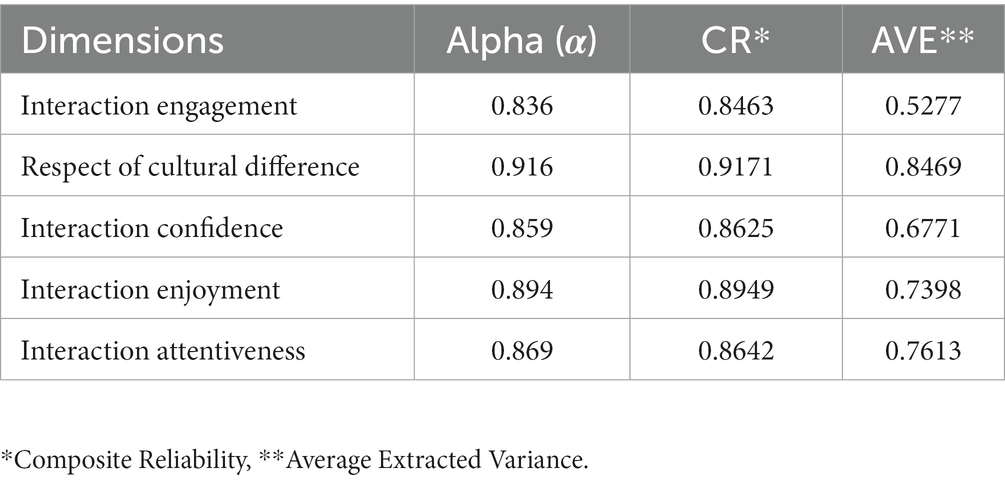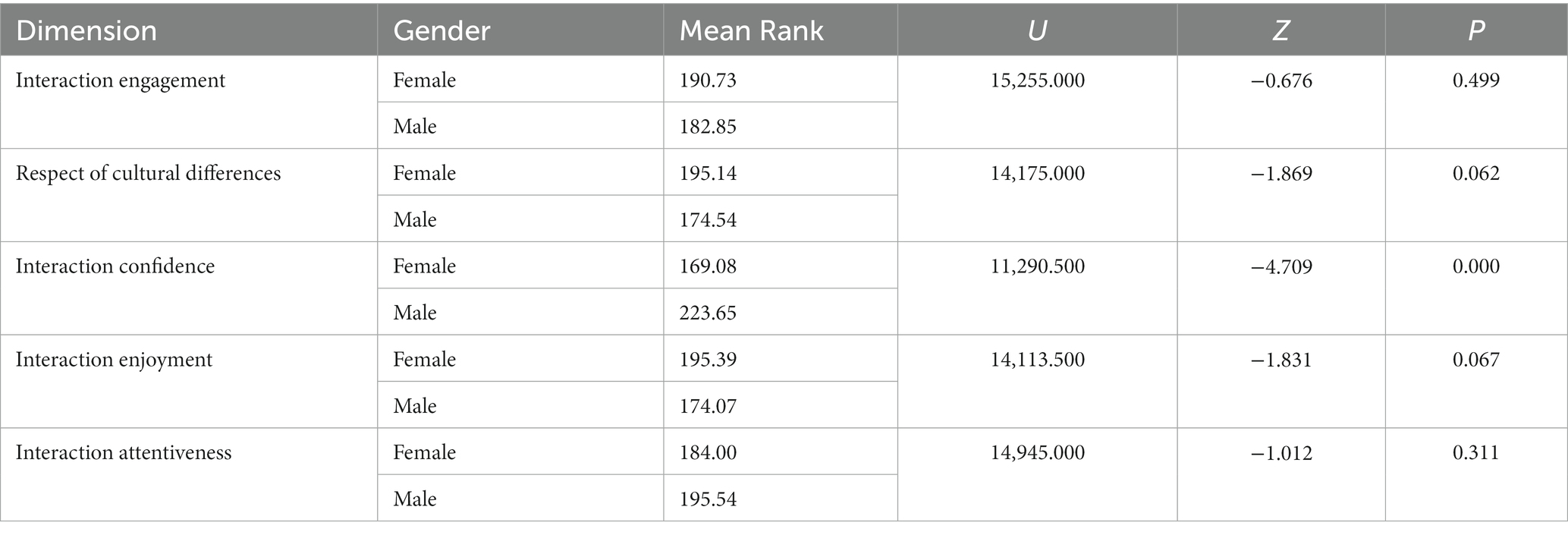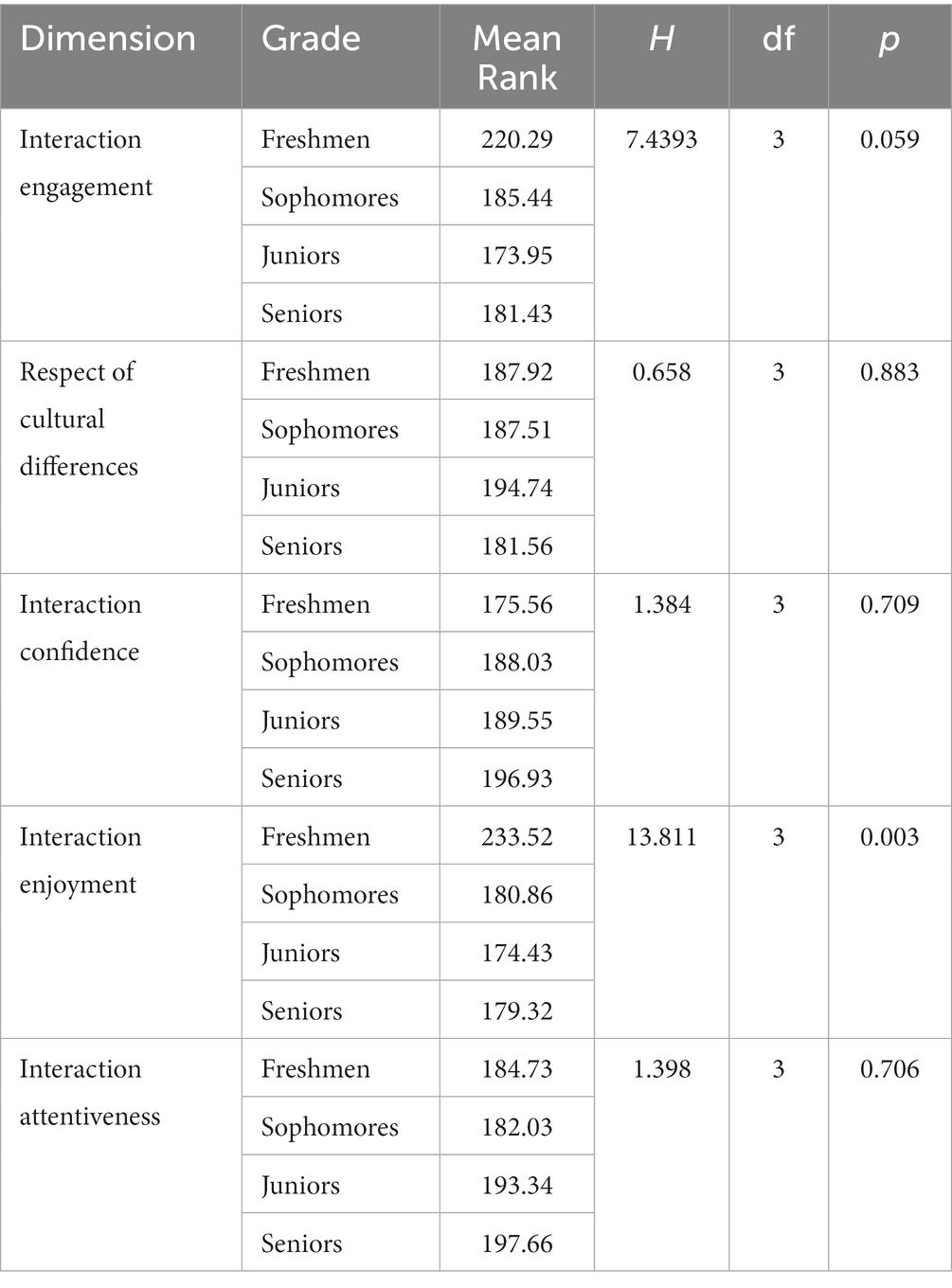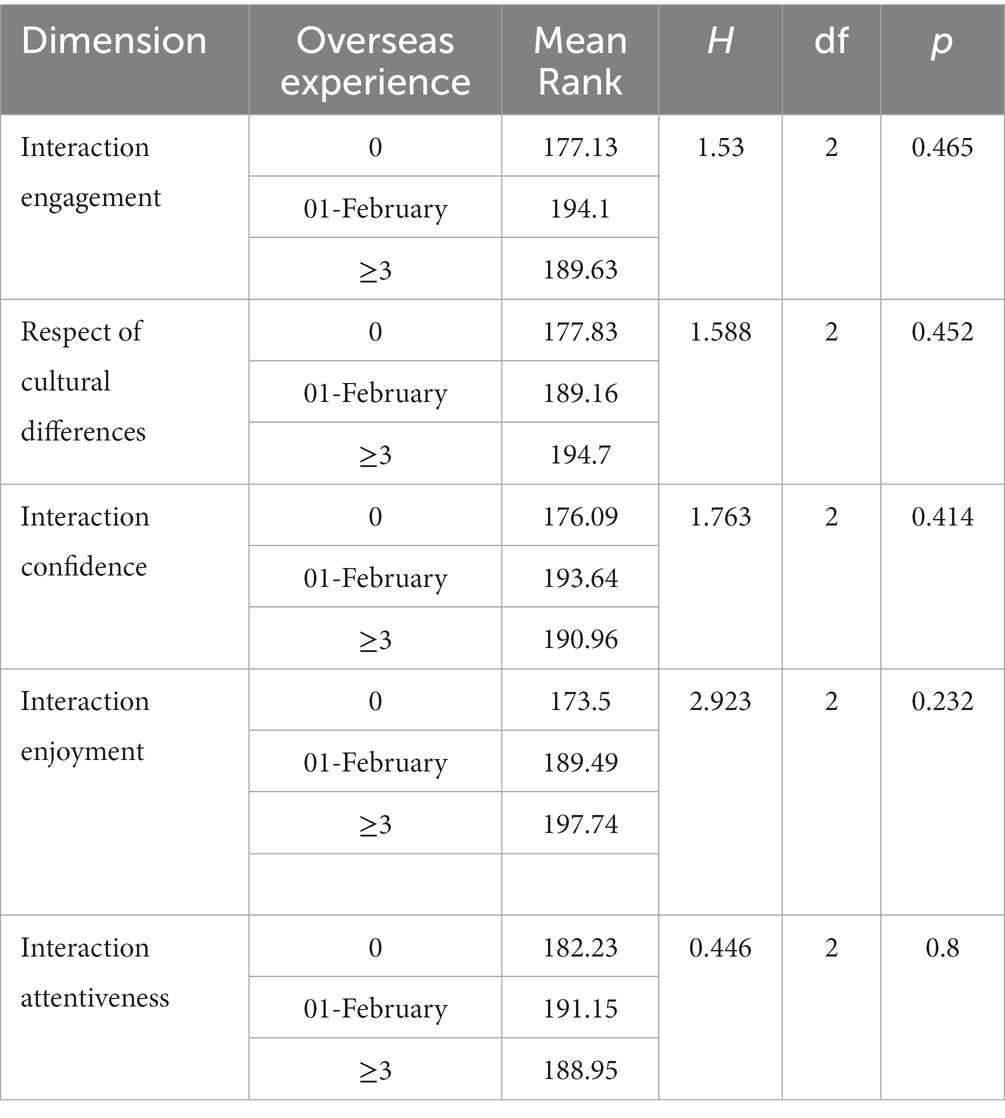- 1Faculty of International Tourism and Management, City University of Macau, Macao, Macao SAR, China
- 2University International College, Macau University of Science and Technology, Macao, Macao SAR, China
Intercultural sensitivity has been regarded as a very important ability necessary for living in multicultural countries and regions. In this research, the quantitative method was used to explore the intercultural sensitivity of university students in Macao, a typical multicultural region in China. By adopting the Intercultural Sensitivity Scale developed by Chen and Starosta and a sociodemographic questionnaire designed by the authors, this study investigated the intercultural sensitivity level of university students in Macao, and explored whether there were any significant differences in student groups in terms of gender, grade, program (language of instruction adopted in a major), courses related to intercultural communication, overseas experience, and foreign language proficiency. The findings of the study on a sample of 375 participants showed that university students in Macao had a relatively high intercultural sensitivity level. There were significant differences in different student groups in terms of gender, grade, courses related to intercultural communication, and foreign language proficiency. This study has implications for both educational policymakers and educators and can ultimately help university students in a multicultural environment improve their intercultural sensitivity and sustainable development.
1. Introduction
Due to the globalization and internationalization of the whole world, intercultural communication competence has become increasingly significant (Jackson, 2011; Deardorff and Jones, 2012; Wang et al., 2017). In a multicultural country or region, it is even more urgent than before to strengthen the cultivation of international talents with intercultural capabilities.
Intercultural communication competence is a complex conceptual system that has been defined in various ways, as a combination of three elements including motivation, knowledge, and skills (Spitzberg and Cupach, 1984), as “the ability to encode and decode meanings in matches that correspond to the meanings held in the other communicator’s repository” (Beamer, 1973), as “the ability to think and act in interculturally appropriate ways” (Hammer et al., 2003), as a combination of affective, cognitive, and behavioral dimensions (Chen and Starosta, 1996; Ting-Toomey, 1999; Sptizber, 2000; Bennett, 2001; Fritz et al., 2001; Müller and Gelbrich, 2001; Graf, 2004), as “the cultural, social, and psychological knowledge that groups of people have about appropriate communication patterns and their ability to use this knowledge in situ [sic]” (Witteborn, 2003), and as a person’s ability to receive and send positive emotional signals before, during and after intercultural interaction (Fritz et al., 2005), etc.
To elaborate on the affective, cognitive, and behavioral dimensions of intercultural competence, Chen and Starosta (1996) proposed three corresponding concepts, including intercultural sensitivity, intercultural awareness, and intercultural adroitness. Among them, intercultural sensitivity is the affective component of intercultural competence. Intercultural sensitivity is a prerequisite for successful intercultural communication (Chen, 1997), and it has become a strong demand for living harmoniously and meaningfully in today’s pluralistic world (Chen, 1997). Greater intercultural sensitivity is associated with greater potential for exercising intercultural competence (Hammer et al., 2003). In other words, only with a high intercultural sensitivity can we recognize differences in a multicultural environment, respect them, and conduct appropriate and effective intercultural communication.
Among the multicultural regions in the world, Macao is a city of 400 years of integration of Eastern and Western cultures (Li, 2017). Leased to Portugal in 1557, Macao became a trading port of southern China and opened to the world. Since the opening of the port, people of different nationalities came to Macao and settled down, and their cultural traditions permeated the life of the city. The interaction between Eastern and Western civilizations has created a unique Macao culture, where diverse ethnic groups, multilingual landscapes, various religious beliefs, different architectural styles, and varied customs have integrated here harmoniously.
Multiculturalism of Macao is firstly manifested in its multicultural population. According to the latest data collected by the Statistics and Census Service of Macao SAR (DSEC), in the third quarter of 2022, Macao has a total population of 671,900, of which 153,841 are non-resident employees. The non-resident employees come from Mainland China (69.3%), the Philippines (16%), Vietnam (5.1%), Indonesia (2.8%), Nepal (1.8%), Hong Kong (1.7%), and other countries and areas (3.3%; DSEC, 2022).
Diverse population has enabled Macao to be a multilingual city. The language landscape of Macao has been summarized by Chen and Li (2019) as “two characters (traditional and simplified), three written languages (Chinese, Portuguese, and English) and four spoken languages (Mandarin, Cantonese, Portuguese, and English)”. Among the written languages, Chinese and Portuguese are the official languages of Macao. While as for the spoken languages, Cantonese is the most widely used one in Macao. Since many of the residents are immigrants from Fujian Province, Hokkien is also widely used in their daily life (Yan, 2016). In addition, employees from the Philippines, Vietnam, Indonesia, and Nepal like to use their native language when communicating with their country fellows.
The fascinating blending of Eastern and Western cultures in Macao is also reflected in its unique multi-religious cultural landscape. Buddhism, Taoism, Catholicism, Christianity, Islam, and other Eastern and Western religions coexist harmoniously. Connected with the diversified religions, the juxtaposition of Western and Chinese architectural heritage sites in the city can be seen here and there. Among the buildings which belong to Historic Center of Macao (China’s 31st World Cultural Heritage), there are many Chinese temples (such as A-ma Temple, Kuantai Temple, and Na Tcha Temple) and Western churches (such as The Cathedral, St. Augustine’s Church, St. Lawrence Church, St. Anthony’s Church). Na Tcha Temple even stands side by side with The Ruins of the St. Paul’s (the façade of what was originally the Church of Mater Dei built in 1602–1640 and the ruins of St. Paul’s College).
As for its varied customs, Macao boasts a unique festival culture, including traditional Chinese celebrations such as Spring Festival, Dragon Boat Festival, Mid-autumn Festival, Double Ninth Festival, as well as the important Western festivals of Easter, Christmas, All Soul’s Day, Procession of our Lady of Fátima, and Feast of Immaculate Conception. Furthermore, with cultural integration, Macao cuisine has become the most inclusive food spectrum. Designated as UNESCO Creative City of Gastronomy in 2017, Macao not only offers Cantonese cuisine and Portuguese cuisine, but also offers all kinds of cuisines from other parts of China, as well as cuisines from other countries like Japan, Korea, Thailand, India, Brazil, Italy, and France.
The integration of Chinese and Western cultures in Macao laid down good foundations for cultivating talents with international vision. University students in Macao not only live in a multicultural social environment, but also study on a multicultural campus. Many academic and research staff have either studied or worked in overseas universities and more and more non-local students come to study in Macao. According to DSES, in the 2019–2020 academic year, non-resident teachers in higher education in Macao came from five continents, accounting for 36.57% of the total number of teachers, and the number of registered non-local students accounted for 52.8% of the total number (DSEDJ, 2020). The programs in universities are conducted in Chinese, English, and Portuguese. Universities in Macao have established multiple forms of partnerships with more than 200 universities in Europe, America, Australia, Mainland China, Taiwan, and Hong Kong in educational programs, academic research, personnel training, student exchanges, and other areas. Students here are surrounded by a dense multicultural atmosphere.
As a famous international tourism city, Macao is committed to building a World Centre of Tourism and Leisure, cultivating talents with intercultural communication competence and international vision becomes urgent. With the increase of multinational companies, the increase of immigration, the emergence of foreign students, the joining of foreign employees, and the development of international conferences and large-scale international events, intercultural communication has become the norm, and cultivating talents with intercultural communication skills and international vision has become an urgent task of development of Macao. The first step of this task is to examine the current intercultural communication competence of Macao university students. Since intercultural sensitivity is a prerequisite for successful intercultural communication (Chen, 1997), the intercultural sensitivity of university students in Macao should be examined first, which is the core of this research.
1.1. Literature review
Intercultural sensitivity has been described for many decades. The research made by Bronfenbrener, Harding, and Gallway in 1958 is one of the earliest studies concerning sensitivity (Chen and Starosta, 1997). It indicates that intercultural sensitivity is similar to interpersonal sensitivity (sensitivity to individual differences). Bennett (1984) put forward the concept of intercultural sensitivity as a continuum in which one can move from ethnocentric stages to ethno-relative stages affectively, cognitively, and behaviorally. Pruegger and Rogers (1993) hold the view that intercultural sensitivity is the evaluation and tolerance of different cultures. Chen and Starosta (1997) put forward that intercultural sensitivity is the affective aspect of intercultural communication competence and defined it as “an individual’s ability to develop a positive emotion toward understanding and appreciating cultural differences that promote appropriate and effective behavior in intercultural communication.” Through further research, Chen and Starosta (2000) emphasized that to promote intercultural competence, interculturally sensitive people must possess self-esteem, self-monitoring, open-mindedness, empathy, interaction involvement, and non-judgment. Hammer et al. (2003) proposed that intercultural sensitivity refers to the ability to discriminate and experience the relevant cultural differences. Sinicrope et al. (2007) pointed out that intercultural sensitivity is an individual’s “ability to step beyond [his/her] own culture and function with other individuals from linguistically and culturally diverse backgrounds.” Chen (2009) defined intercultural sensitivity as the positive emotional ability of individuals to understand and appreciate cultural differences and promote appropriate and effective intercultural communication. Moore-Jones (2018) held the view that intercultural sensitivity mainly exists within individuals and is related to the evolution of their attitudes toward cultural differences, rather than constituting a specific expression of their behavior. It helps to develop an ability in the affective dimension, enabling people to understand the differences between their own culture and others, thereby placing themselves in the position of others and perceiving and understanding the world in different ways.
Intercultural sensitivity research has experienced two stages: theoretical model construction and empirical research. In the field of applied linguistics and language education, there are currently 4 influential scales: (1) Bhawuk and Brislin (1992) created the Intercultural Sensitivity Inventory (ICI) to measure the intercultural sensitivity in both individualist and collectivist cultures. (2) Cushner (1986) developed the Inventory of Cross-cultural Sensitivity to measure people’s sensitivity to different cultures. The scale includes cultural integration, behavioral response, intellectual interaction, attitudes toward others, and empathy. (3) Hammer and Bennett (1998), based on cognitive psychology and constructivist theory, constructed the Intercultural Development Inventory (IDI), which has been used to measure people’s orientations toward cultural differences, including denial, defense, minimization, acceptance, adaptation, and integration. The scale has been widely used in the United States, Europe, and Asia. However, the fee for using this instrument (about US$1,500) has deterred many researchers. (4) Chen and Starosta (2000) believed that intercultural sensitivity is the emotional performance of intercultural communicative competence and developed the Intercultural Sensitivity Scale (ISS). The scale includes 5 dimensions: intercultural engagement, respect of cultural difference, interaction confidence, interaction enjoyment, and interaction attentiveness.
As one of the intercultural sensitivity testing tools with high reliability (Cronbach’s α = 0.88), the ISS developed by Chen and Starosta (2000) has been widely adopted in assessing people’s intercultural sensitivity in many countries, such as China, Thailand, Korea, Malaysia, Iran, Germany, United States, Chile, and Spain. The research respondents included students of different educational levels, English teachers, foreign language teaching assistants of Fulbright projects, foreign trade talents, employees of transnational companies, company boards, etc. The empirical research mainly covered surveys on intercultural sensitivity levels, comparison of intercultural sensitivity levels among different groups, psychometric testing of the ISS scale, correlation studies on factors affecting intercultural sensitivity, and the relationship between intercultural sensitivity and intercultural communication competence.
Fritz et al. (2001) tested ISS with a sample of 541 German students of business administration. Confirmatory factor analysis showed that the scale held satisfactorily. Peng (2006) investigated the intercultural sensitivity of English major students, non-English major students, and multinational employees in China. Results showed different weightings of the 5 elements of intercultural sensitivity of the 3 subsamples. Hu (2011) measured the IS level of 175 undergraduates in Shanxi University in China and found that the mean value of respect of cultural difference was the highest. Soltani (2014) studied the effect of ethnic background on Iranian EFL learners’ intercultural sensitivity and found a strong relationship between them. Zhang (2015) surveyed intercultural sensitivity and English-cultural-loaded vocabulary acquisition of 500 non-English major undergraduate students and found a positive correlation between them. Nameni and Dowlatabadi (2019) investigated the intercultural communicative competence and intercultural sensitivity of 400 medical students in Iran based on ethnic differences and found that the four ethnic groups had moderate levels of ICC and IS. Zhang and Han (2019) measured and compared the intercultural sensitivity of American students from a mid-sized state university in the south and a small-sized private liberal arts school in the mid-west, and found that students from the mid-sized state university were more interculturally sensitive than their counterparts in two dimensions of the Intercultural Sensitivity Scale (ISS). Loebel et al. (2021) adapted and validated ISS in a sample of university students from Chile and verified the factor structure of the scale.
In addition to the above research, the previous study has identified the influencing factors of intercultural sensitivity, such as gender (Holm et al., 2009; Petrović and Zlatković, 2009; Segura-Robles and Parra-González, 2019), overseas experience (traveling/studying/exchange program; Burdette-Williamson, 1997; Olson and Kroeger, 2001; Straffon, 2003; Engle and Engle, 2004; Williams, 2005; Gordon and Mwavita, 2018; Yurur et al., 2018), and foreign language proficiency (Burdette-Williamson, 1997; Olson and Kroeger, 2001; Paige et al., 2003; Engle and Engle, 2004).
Though the intercultural sensitivity of university students in many countries and areas has been well investigated, the research on intercultural sensitivity level of university students in Macao has yet to be made.
1.2. Research question
The present study intends to enrich the existing literature about the empirical research on intercultural sensitivity by measuring the IS level of university students in Macao and by exploring whether there are any significant differences in student groups in terms of gender, grade, program (language of construction adopted a major), courses related to intercultural communication (IC-related courses), overseas experience, and foreign language proficiency test.
To address the objectives of the present study, the following research questions were posed:
(1) What is the intercultural sensitivity level of university students in the multicultural city Macao?
(2) Concerning the IS levels of university students in Macao, are there any significant differences in student groups in terms of gender, IC-related courses, grade, program, overseas experience, and foreign language proficiency?
2. Methods
In this research, the quantitative method was adopted as this method has two significant advantages. First, it can be administered and evaluated quickly. There is no need to spend time at the organization prior to administering the survey, and the responses can be tabulated in a short time. Second, numerical data obtained through this approach facilitates comparisons between groups, as well as allowing determination of the extent of agreement or disagreement between respondents (Yauch and Steudel, 2003).
2.1. Sampling method
In this research, convenience sampling method was adopted to collect data. Convenience sampling method is a type of non-probability or nonrandom sampling in which members of the target population are selected for the purpose of the study if they meet certain practical criteria, such as geographical proximity, availability at a certain time, easy accessibility, or the willingness to volunteer (Dörnyei, 2007). Furthermore, this sampling strategy is favored in order to obtain an in-depth description of a focused individual in a population (Creswell et al., 2013). “Captive audiences, such as students, in the researchers’ own institution are prime examples of convenience sampling” (Dörnyei, 2007). As the respondents of this research are university students from the first author’s own university, they are conveniently available subjects and the survey is easy to operate, the convenience sampling method is the best fit for the purpose of this research.
2.2. Participants
A sample of 375 Macao university students from City University of Macau was selected through a convenient sampling method. Among the participants, there were 130 males (34.7%) and 245 females (65.3%). They came from four grades, including 63 freshmen, 157 sophomores, 82 junior students, and 73 senior students. As for the programs, 94 students came from the Chinese program, 250 students came from the English program, and 31 students came from the Portuguese program.
2.3. Instruments
To reach the research objective, two measurement instruments have been adopted.
One instrument is the Intercultural Sensitivity Scale (ISS) developed by Chen and Starosta (2000), as shown in Table 1. ISS is a 5-point Likert-type scale (1 = totally disagree; 2 = disagree; 3 = neutral; 4 = agree; 5 = totally agree). No changes have been made to the items in the scale. Negative questions were reverse-scored and recoded to calculate the mean value. This instrument was used to answer research question 1.
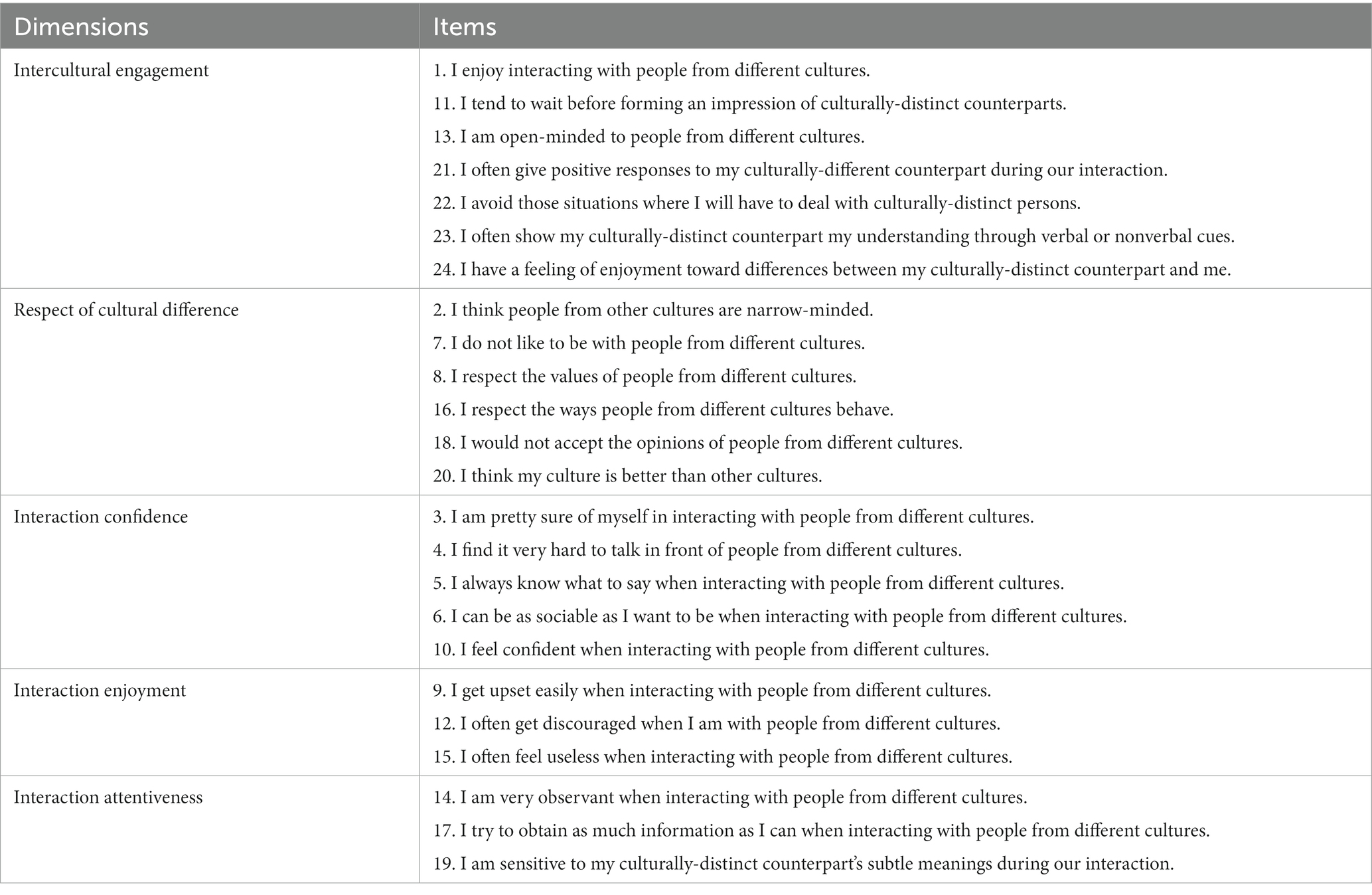
Table 1. The Intercultural Sensitivity Scale [ISS, (Chen and Starosta, 2000)].
Another instrument was designed by the authors. It is a sociodemographic questionnaire concerning gender, grade, program, IC-related courses, overseas experience, the language proficiency test, and ways of multicultural contacts among university students in Macao. This instrument was used to answer research question 2.
The respondents were asked to answer the questions in the two questionnaires at one time (Figure 1).
2.4. Procedures
To check semantic coherence, the ISS went through the forward-backward-forward translation technique. The back-translated version of the scale was reviewed by monolinguals of both English and Chinese to discern possible errors that could influence the understanding of the translated instrument.
Before the survey, informative meetings were held with the students, the purpose of this research and the ethical principles of the project were addressed to them and they were informed that the survey would be anonymous, and the data would be for academic research purposes only. Students who agreed to participate in the study filled out the Chinese version of ISS through Tencent Questionnaire voluntarily and anonymously. In total, 385 copies of a questionnaire were distributed from July 1st to 8th, 2022. Subsequently, 380 were collected and 375 were analyzed after excluding 5 invalid ones (with incomplete data).
2.5. Data analysis method
Data management and analysis were performed with SPSS25.0. Descriptive analysis, frequency, and percentage were used for an overall description of the participants. The mean value of each subscale was measured. Mean values of 1–2.5 were interpreted as “low,” 2.5–3.5 as “moderate,” and 3.5–5 as “high” levels of IS (Nameni and Dowlatabadi, 2019).
The samples used for comparison in this study did not meet the classic requirements of parametric tests—normality (data have a normal distribution), homogeneity of variances (groups have the same variance), and independence (whether two variables or attributes are independent). As non-parametric studies have the same statistical rigor as parametric studies (Mumby, 2002), two kinds of nonparametric tests, including the Mann–Whitney U test and the Kruskal-Wallis H test, were carried out in this study. The Mann–Whitney U test, which is known as the Wilcoxon rank-sum test, tests for differences between two groups on a single, ordinal variable with no specific distribution. When data do not meet the parametric assumptions of the t-test, the Mann–Whitney U tends to be more appropriate (McKnight and Najab, 2010). The Kruskal-Wallis is a nonparametric statistical test that assesses the differences among three or more independently sampled groups on a single, non-normally distributed continuous variable. It is a more generalized form of the Mann–Whitney U test and is the nonparametric version of the one-way ANOVA (McKnight and Najab, 2010).
3. Results
3.1. Reliability analysis
In this research, different analyses, including Cronbach’s Alpha (α), Composite Reliability (CR), and Average Extracted Variance (AVE), were carried out to verify the reliability of the survey. The results showed that the reliability indices were acceptable, and as the values of Cronbach’s alpha (α) and composite reliability (CR) were above 0.70, and the values of average variance extracted (AVE) were higher than 0.50, and there is no problem with the convergent validity. The results of the reliability analysis are shown in Table 2.
3.2. Descriptive analyses
Descriptive data were generated for all variables. The results of the descriptive analyses are shown in Table 3. What is striking about the data in this table is that interaction engagement, respect of cultural difference, interaction enjoyment, and interaction attentiveness have high mean values (>3.5), while the mean value for interaction confidence (3.1) is on moderate level.
3.3. Inferential analyses
The first inferential analysis (as in Table 4) was carried out on the difference between males and females. In the results in terms of gender, there was a significant difference in interaction confidence, with p = 0.000. In this case, the male students obtained a higher mean rank (MR = 223.65) than that of the female students (MR = 169.08).
The second inferential analysis (as in Table 5) was made on the differences between the students who have taken the IC-related courses and those who have not. Among the participants, 267 (71.2%) students have studied the courses related to intercultural communication, and 108 (28.8%) students have not. Mann–Whitney U test reflected that there were significant differences in interaction confidence (p = 0.006) and interaction attentiveness (p = 0.026). Concerning interaction confidence, the students who have taken the courses related to intercultural communication obtained a higher mean rank value (MR = 193.77) than those who have not (MR = 173.73) and for interaction attentiveness, the students who have taken the courses related to intercultural communication obtained a higher mean rank value (MR = 197.57) than those who have not (MR = 164.35).
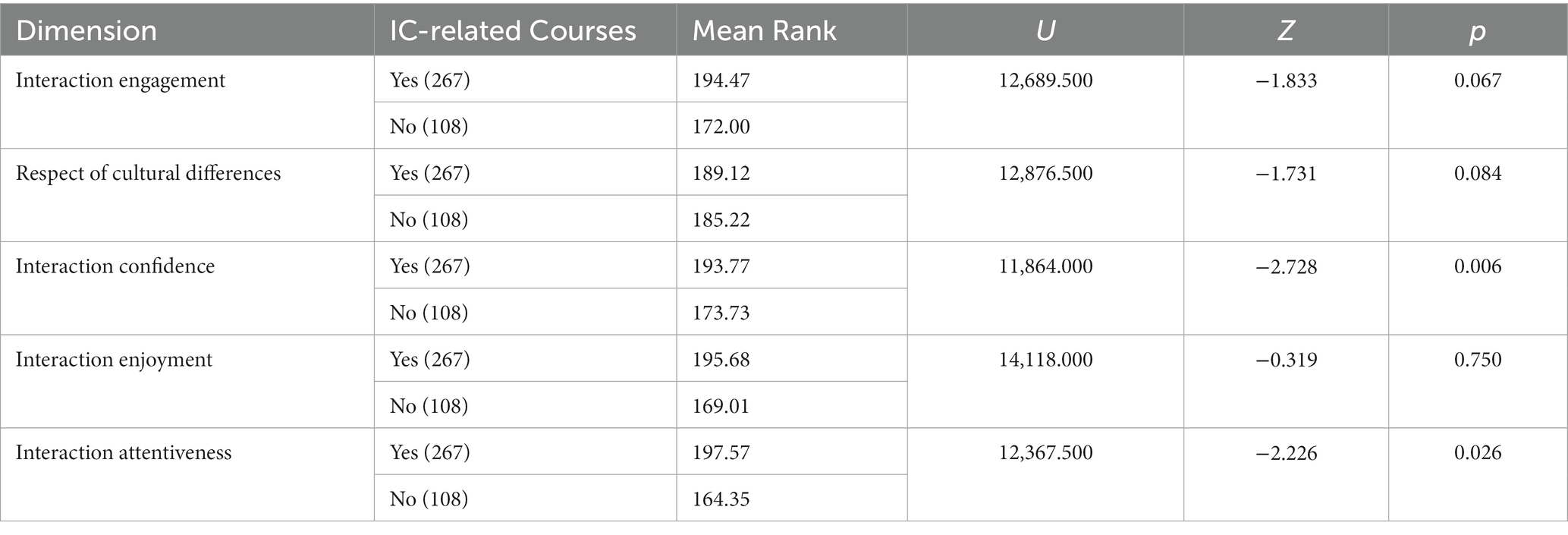
Table 5. Mann–Whitney U test for different dimensions according to whether one has taken the IC-related courses.
The analysis on the differences among the students according to the grades is shown in Table 6. The Kruskal-Wallis H test indicated that there was a significant difference in terms of interaction enjoyment, with p = 0.003. The most surprising aspect of the data is that the mean rank of the freshmen (MR = 233.52) was the highest among the four grades.
Table 7 shows the results on the differences among student groups in terms of program. In higher education in Macao, there are three programs: Chinese, English, and Portuguese. Among the participants, 94 students majored in Chinese program, 250 students majored in English program, and 31 students majored in Portuguese program. The data reflected that no significant difference was found among the participants of the three programs.
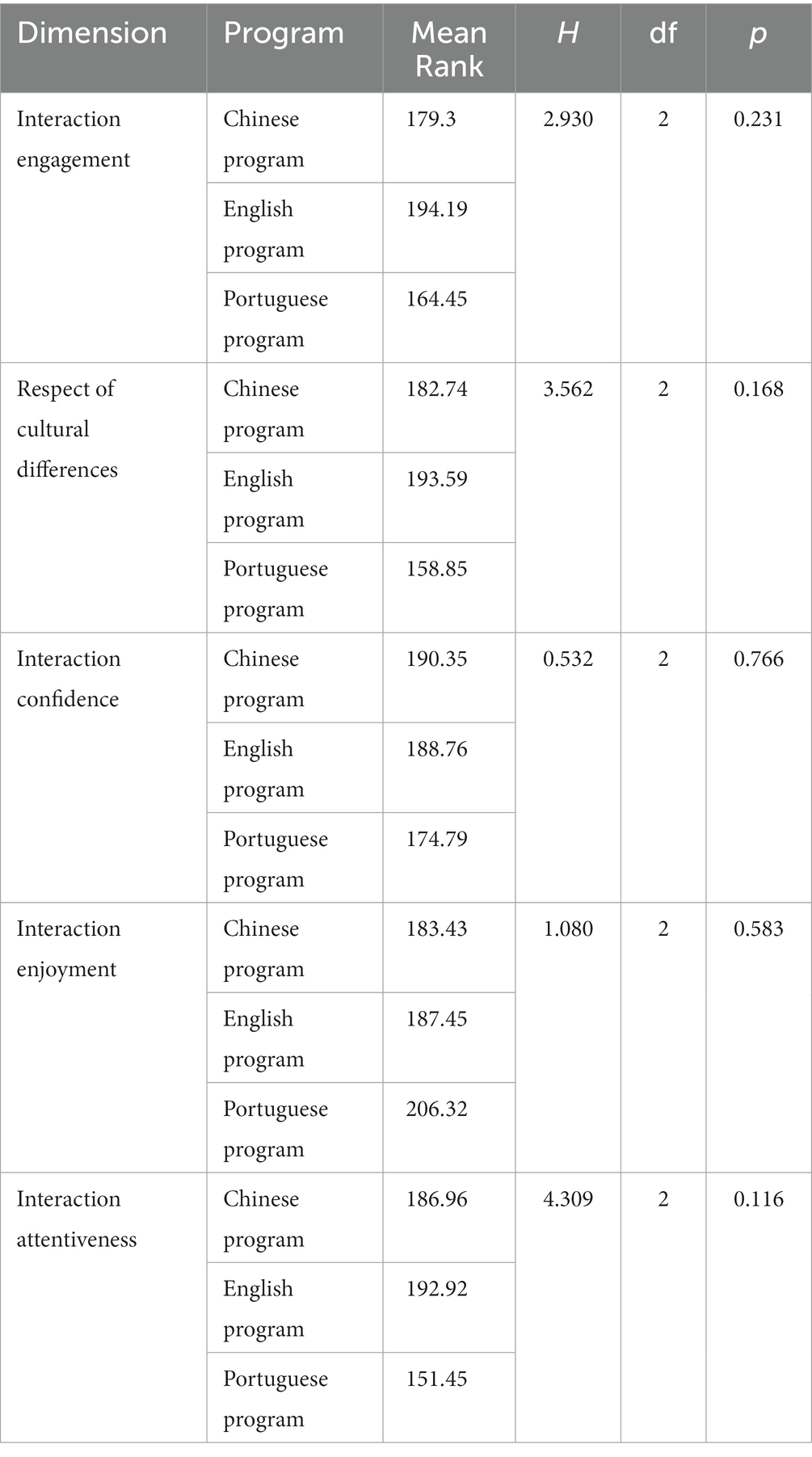
Table 7. Kruskal-Wallis H test for different dimensions according to program (language of instruction adopted in one’s major).
Of the 375 students who completed the questionnaire, as for overseas experiences (including study abroad, study tour, internship, traveling, etc.), 101 of them (27%) had no experience abroad, 146 of them (39%) had 1–2 overseas experiences, and128 of them (34%) had been abroad 3 or more times. The data in Table 8 indicated that no significant difference was found among the students with different overseas experiences.
The results obtained from the inferential analysis on the differences between the students who have passed a foreign language proficiency test and those who have not are presented in Table 9. The foreign language proficiency tests include IELTS, TOEFL, TOEIC, College English Test Band 4, College English Test Band 6, Public English Test, China Accreditation Test for Translators and Interpreters, Business English Certificate, and other foreign language proficiency tests (such as Test for Proficiency in Korean, the Japanese-Language Proficiency Test), etc. It is shown that 242 (64.5%) participants have passed a foreign language proficiency test, and 133 (35.5%) have not. There was a significant difference between the students who have passed a language proficiency test and those who have not in terms of interaction confidence, with p = 0.017 and the mean rank of those who have passed a foreign language proficiency test (MR = 197.77) was higher than that of those who have not (MR = 170. 23).
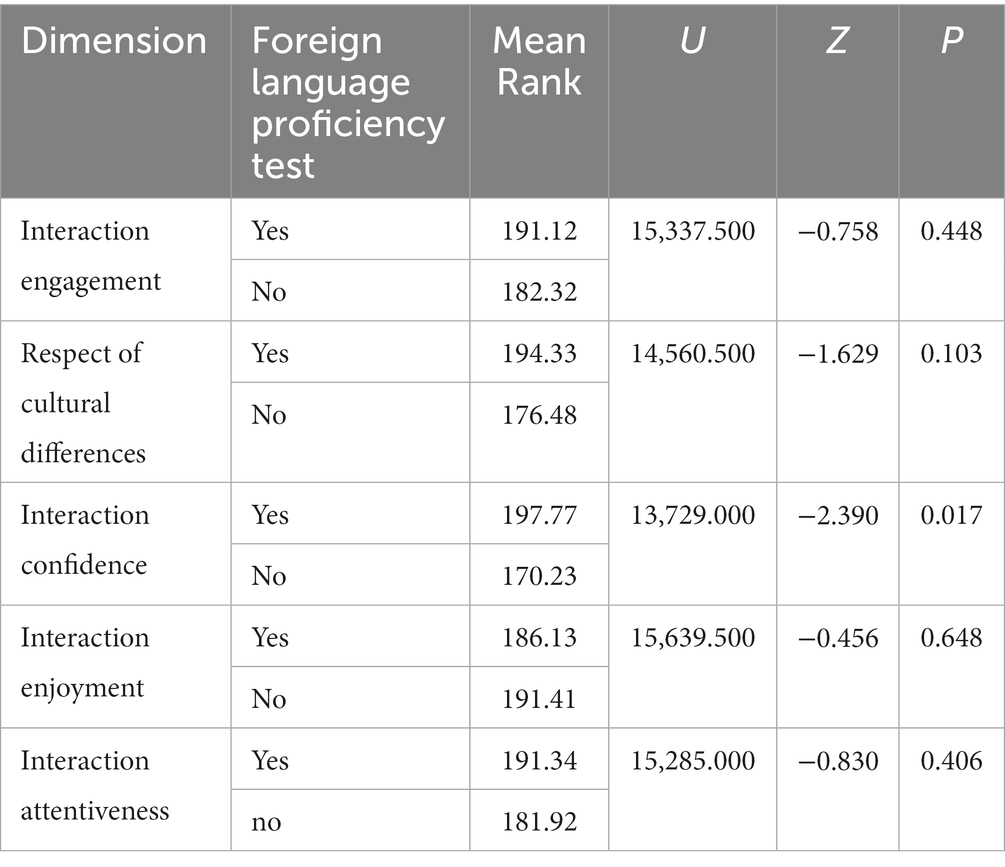
Table 9. Mann–Whitney U test for different dimensions according to foreign language proficiency test.
4. Discussion and conclusion
The present study aimed to investigate the IS level of Macao university students and explore whether there were any significant differences in student groups in terms of gender, grade, program, courses related to intercultural communication, overseas experience, and foreign language proficiency. The research data showed that the university students in Macao had a relatively high IS level: Among the five dimensions, three dimensions, including interaction engagement, respect of cultural difference, and interaction attentiveness, had mean values which were higher than 4. The mean value of respect of cultural difference was the highest (4.3307), and that of interaction confidence (3.1076) was the lowest. A possible explanation for the relatively high level of intercultural sensitivity of university students in Macao might be the following:
First, multicultural context contributes significantly to students’ high level of intercultural sensitivity, which is consistent with previous studies (Roh, 2014; Segura-Robles and Parra-González, 2019). University students in Macao have been surrounded by a uniquely multicultural environment. Walking on the streets of Macao, they can see the bi-lingual or tri-lingual street signs all over the city. Getting on the buses, they can hear Chinese, Cantonese, Portuguese, and English adopted in the automatic stop announcer. They meet teachers, students, and even working staff of different cultural background. Further, they can visit the multicultural places of interest in Macao and take part in the international events hold here. For example, just from October to November 2022, there were a series events held in Macao, to name a few, the 34th Macao International Music Festival, the 4th “Encounter in Macao— Arts and Cultural Festival between China and Portuguese-speaking Countries,” the 25th Lusofonia Festival (featuring the “China and Portuguese-speaking Countries Film Festival,” the “Traditional Music and Dance Performance in the Community” and the “Chinese and Portuguese Picture Book Fair”), the 22nd Macau Food Festival, and the 69th Macau Grand Prix. Having been immersed in a fascinating heterogeneous city of different cultures, university students in Macao can not only perceive, understand, accept, and respect cultural differences, but also engage in intercultural communication more actively.
Second, there are many other opportunities for university students in Macao to have direct and indirect intercultural communication contact as indicated in demographic information. For indirect intercultural contacts, in addition to taking the compulsory foreign language courses, 267 (71.2%) of the participants had taken courses related to intercultural communication, and 350 (93%) of them read foreign literary classics, watched foreign movies and TV programs, or listened to foreign music and for direct intercultural contacts, 274 (73%) of the students had overseas experience, 258 (68.8%) of them traveled abroad, and 128 (34%) of them participated in international exchange programs. Furthermore, among these participants, 258 (68.8%) of them have passed a language proficiency test (IELTS, TOFEL, CET-4, CET-6, etc.) According to Yurur et al. (2018), exposure to other cultures by participating previously in student exchange programs, work, and travel programs, and spending a long period of time abroad increased people’s intercultural sensitivity. All the participants in this research were not lacking an opportunity to have direct interaction with people from different cultures in Macao. With knowledge about intercultural communication, immersing in a multi-cultural harmonious environment, various intercultural contacts enabled them to discern, understand, and respect cultural differences. The findings demonstrated that most of them did not consider their own culture better than others, but respected values and behaviors of people from other cultures. They did not resist interacting with people from different cultures, and blindly reject the opinions of people from different cultures. They engaged in intercultural communication actively, focused on the intercultural process and effects, and got enjoyment in intercultural communication.
However, in the current study, the mean value of the interaction confidence of the university students in Macao was not very high. This result is similar to the research of certain previous studies (Hua, 2020). There are several possible explanations for it. First, the result is related to the language proficiency of the participants, because limited language proficiency is identified as a major obstacle in developing social skills and confidence (Khawaja and Stallman, 2011) and according to Clement’s linguistic confidence theory, due to limited contact before immersion, participants cannot have sufficient linguistic confidence, hence their interaction confidence cannot be built up (Wong, 2015). In this survey, 35.5% of the participants have not passed a language proficiency test. Furthermore, research data of this study (as in Table 9) indicated that the mean rank of those who have passed a foreign language proficiency test was higher than that of those who have not. Second, another possible explanation for this is lack of real-life intercultural communication practice. Precisely, social distancing and lockdown during the COVID-19 pandemic period decreased the quantity and quality of real-life communication which influenced the interaction confidence of the participants. Confidence in intercultural communication comes from communication behavior. In the developmental nature of intercultural sensitivity, the more frequently one communicates, the more confident one becomes (Bennett, 1986). Third, this result is also likely related to personality. Research on Chinese students’ perceived barriers to effective intercultural communication (Zhang and Zhou, 2021) found that two major personality-related barriers, including shyness and lack of confidence, influenced the participants’ performance in intercultural communication.
The demographic information indicated certain specific characteristics of the intercultural sensitivity level of university students in Macao. Concerning the relationship between gender and the intercultural sensitivity level, the current study found that there was a significant difference in interaction confidence. The male students showed a higher mean rank than that of the female students. This result differs from the previous study results made by Kim and Mo (2011) and Mellizo (2017), but it is broadly consistent with the findings of Meydanlioglu et al. (2015) and Boudouaia et al. (2022). Given that scholars have got exact opposite results, it is difficult to explain this result in this research; a further study with more focus on interaction confidence concerning gender is therefore suggested.
As for the relationship between IC-related courses taken by the university students in Macao and the IS level of them, the results of this study showed that there were significant differences in interaction confidence and interaction attentiveness. The students who have taken the IC-related courses showed more interaction confidence and higher interaction attentiveness. This research result reflected the effectiveness of setting IC-related courses in enhancing IS level of university students. The findings showed consistency with previous literature, which argued that it is necessary to emphasize the formulation of more IC-related courses (Liu et al., 2022).
Regarding the IS level of students from different grades, there was a comparison among students from four grades. This study found that there was a significant difference among the students in terms of interaction enjoyment and the mean rank of the freshmen was the highest. A probable explanation for this surprising result is that all the freshmen in this survey were language majors. This result is consistent with the findings of previous studies on non-language majors and language majors. Wei (2019) made research on the intercultural sensitivity of non-English major freshmen and found that the mean rank of interaction enjoyment of the participants was the lowest. The barriers of the non-English majors’ intercultural communication were summarized as the following: the deficiency of communication skills, the deficiency of culture knowledge, the deficiency of experience, and the deficiency of confidence. In addition, Wattanavorakijkul (2020) found that English majors had more exposure to using English and communicating with foreigners than participants in other disciplines. Their English proficiency enabled them to enjoy intercultural experiences and interact more with friends from different cultures. The language major freshmen of this research studied language skills of listening, speaking, reading, writing, and translation every day. They were accustomed to speaking in English or Portuguese, and did not have obvious language barriers in communication, hence had more interaction enjoyment than other participants.
In higher education in Macao, there are three programs (languages of instruction adopted in one’s major): Chinese, English, and Portuguese. The data reflected that no significant difference was found among the participants of the three programs. There are several possible explanations for this result. First, the sources of students for these three programs are similar, mainly students from mainland China and local students from Macao. Second, most of the teachers in each faculty have international education background. Third, all the students are in the same cultural atmosphere.
The data of this study indicated that there was no significant difference between those who have been abroad and those who have not. With respect to the relationship between the overseas experience and one’s level of intercultural sensitivity, the findings of different academic research results were controversial. Some researchers (Anderson et al., 2006; Yashima, 2010) provided evidence that participants with short-term overseas experience exhibit greater improvement in intercultural sensitivity than those without, and some (Kirillova et al., 2015) declared that short-term overseas experience (such as volunteer tourism) has the potential to simultaneously promote and inhibit intercultural understanding. In this study, as the contact quality and contact quantity of the students’ overseas experience have not been investigated, and whether the multicultural academic environment has enhanced the IS level of the students was not clear. As a result, the reasons behind this finding require further research.
Finally, as for the relationship between the foreign language proficiency test and the IS level of the students, there was a significant difference in terms of interaction confidence. Those who have passed a foreign language proficiency test had higher IS level than those who have not. This research result is like that of Iqbal (2019) which put forward that foreign language proficiency is associated with decreased fear of language barriers.
Intercultural sensitivity has been regarded as a very important ability necessary for living harmoniously in today’s pluralistic world. It is not an instinctive and universal aspect of human behavior. This study examined the IS level of university students from Macao and enriched the existing literature about the empirical research on intercultural sensitivity. It has been indicated that intercultural sensitivity is a developmental process, and cultural environment and training are two important points in the development of high levels of intercultural sensitivity. The results indicated the influence of intercultural experience, including physical experience and indirect exposures on IS levels of university students in Macao. The findings of this study are especially useful to education policymakers and educators in identifying the strengths and weaknesses of their university students in intercultural sensitivity. For Macao, Education and Youth Development Bureau of Macao (DSEDJ) can put forward policies that are more conducive to enhancing the intercultural sensitivity level of Macao university students and university teachers can arrange their classroom teaching and extracurricular activities more scientifically and efficiently. Finally, the intercultural sensitivity of the college students can be further improved.
5. Limitations and future research
This study has several limitations and elicits suggestions for future research on intercultural sensitivity. First, there is a limitation on generalizing these results to the entire Macao undergraduates, since the sampling was based on students in City University of Macau. Second, the ISS scale adopted in this study was European-centric. It is necessary to consider whether the results based on the instrument scale could be an adequate reflection of the characteristics of the intercultural sensitivity among Macao university students. Third, qualitative method is adopted in this research, but it is limited to a self-report survey. An explanatory sequential mixed method, including self-report survey, knowledge-based test, and interview, could be adopted in future research.
Data availability statement
The original contributions presented in the study are included in the article/supplementary materials, further inquiries can be directed to the corresponding author.
Ethics statement
The studies involving human participants were reviewed and approved by the Ethics Committee of City University of Macau. The patients/participants provided their written informed consent to participate in this study.
Author contributions
HC contributed to the conception, design of the study, and wrote the first draft of the manuscript. HC and BH organized the database and performed the statistical analysis. All authors contributed to the manuscript revision, read, and approved the submitted version.
Funding
This research was funded by Macao Foundation, grant number MF2033.
Conflict of interest
The authors declare that the research was conducted in the absence of any commercial or financial relationships that could be construed as a potential conflict of interest.
Publisher’s note
All claims expressed in this article are solely those of the authors and do not necessarily represent those of their affiliated organizations, or those of the publisher, the editors and the reviewers. Any product that may be evaluated in this article, or claim that may be made by its manufacturer, is not guaranteed or endorsed by the publisher.
References
Anderson, P. H., Lawton, L., Rexeisen, R. J., and Hubbard, A. C. (2006). Short-term study abroad and intercultural sensitivity: a pilot study. Int. J. Intercult. Relat. 30, 457–469. doi: 10.1016/j.ijintrel.2005.10.004
Beamer, L. (1973). Learning intercultural communication competence. J. Bus. Commun. 29, 285–303. doi: 10.1177/002194369202900306
Bennett, M. J. (1984). Towards ethnorelativism: a developmental model of intercultural sensitivity. Paper presented at the annual conference of the council on international exchange, Minneapolis, Minnesota.
Bennett, M. J. (1986). A developmental approach to training for intercultural sensitivity. Int. J. Intercult. Relat. 10, 179–196. doi: 10.1016/0147-1767(86)90005-2
Bennett, M. J. Intercultural Competence for Global Leadership. Oregon: The Intercultural Communication Institute, (2001).
Bhawuk, D. P. S., and Brislin, R. (1992). The measurement of intercultural sensitivity using the concepts of individual and collectivism. Int. J. Intercult. Relat. 16, 413–436. doi: 10.1016/0147-1767(92)90031-O
Boudouaia, A., Htun, K., Al-Qadri, A., Saroh, Y., and Beddiaf, A. (2022). Intercultural sensitivity of English language teachers in Algeria. Cogent Educ. 9:2042034. doi: 10.1080/2331186X.2022.2042034
Burdette-Williamson, P. (1997). The relationship of intercultural sensitivity to teachers’ cross-cultural experiences and other factors. J. Fam. Consumer Sci. Educ. 15, 36–48.
Chen, G. M. (1997). A Review of the Concept of Intercultural Sensitivity. Paper presented at the Biennial Convention of the Pacific and Asian Communication Association.
Chen, G. M. (2009). Beyond the dichotomy of communication studies. Asian J. Commun. 19, 398–411. doi: 10.1080/01292980903293312
Chen, D., and Li, J. (2019). Xianghui Cheng: Macao is a rich mine for sociolinguistic research. Available at: https://baijiahao.baidu.com/s?id=1632670066086322359 (Accessed August 15, 2022).
Chen, G. M., and Starosta, W. J. (1996). Intercultural communication competence: a synthesis. Ann. Int. Commun. Assoc. 19, 353–383. doi: 10.1080/23808985.1996.11678935
Chen, G. M., and Starosta, W. J. (1997). Chinese conflict management and resolution: overview and implications. Intercult. Commun. Stud. 7, 1–16.
Chen, G. M., and Starosta, W. J. (2000). The development and validation of the intercultural communication sensitivity scale. Hum. Commun. 3, 1–15. doi: 10.1037/t61546-000
Creswell, J. W., Klassen, A. C., Clark, V. L. P., and Smith, K. C. Best Practices for Mixed Methods Research in the Health Sciences. Bethesda, MD: National Institutes of Health. (2013). 541–545.
Cushner, K. The Inventory of Cross-Cultural Sensitivity. Kent, OH, School of Education, Kent State University. (1986).
Deardorff, D. K., and Jones, E. (eds) (2012). “Intercultural Competence,” in The SAGE Handbook of International Higher Education (Thousand Oaks, CA: SAGE Publications), 13–15.
DSEC. (2022). Demographic Statistics. Available at: https://www.dsec.gov.mo/getAttachment/3b99fbc5-a966-4df5-b1e0-a21513ea798b/SC_DEM_FR_2022_Q2.aspx (Accessed November 01, 2022).
DSEDJ. (2020). Report on indicators of higher education in Macao (2019-2020). Available at: https://es.dsedj.gov.mo/big5/education/pdf/Report2019-2020.pdf (Accessed November 01, 2022).
Engle, L., and Engle, J. (2004). Assessing language acquisition and intercultural sensitivity development in relation to study abroad program design. Front. Interdiscipl. J. Study Abroad X, 219–236.
Fritz, W., Graf, A., Hentze, J., Möllenberg, A., and Chen, G. M. (2005). An examination of Chen and Starosta’s model of intercultural sensitivity in Germany and United States. Intercult. Commun. Studies. 14, 53–64.
Fritz, W., Mollenberg, A., and Chen, G. M. (2001). Measuring intercultural sensitivity in different cultural context. Intercult. Commun. Stud. 11, 165–176.
Gordon, S. R., and Mwavita, M. (2018). Evaluating the international dimension in an undergraduate curriculum by assessing students’ intercultural sensitivity. Stud. Educ. Eval. 59, 76–83. doi: 10.1016/j.stueduc.2018.03.005
Graf, A. (2004). Assessing intercultural training designs. J. Eur. Ind. Train. 28, 199–214. doi: 10.1108/03090590410527618
Hammer, M. R., and Bennett, M. J. The Intercultural Development Inventory (IDI) Manual. Portland, OR: Intercultural Communication Institute (1998).
Hammer, M. R., Bennett, M. J., and Wiseman, R. (2003). Measuring intercultural sensitivity: the intercultural development inventory. Int. J. Intercult. Relat. 27, 421–443. doi: 10.1016/S0147-1767(03)00032-4
Holm, K., Nokelainen, P., and Tirri, K. (2009). Relationship of gender and academic achievement to Finnish students’ intercultural sensitivity. High Abil. Stud. 20, 187–200. doi: 10.1080/13598130903358543
Hu, Y. (2011). A survey of intercultural sensitivity of university students. Foreign Lang. World 3, 68–73.
Hua, Y. (2020). “A survey of the intercultural sensitivity of English majors in nationality university of China,” in 8th International Education, Economics, Social Science, Arts, Sports and Management Engineering Conference (IEESASM) (London: Francis Academic Press), 151–157.
Iqbal, Z. (2019). Eastern promises fulfilled: the differential impact of marketing-focused short-term study programs in India and Japan. Front. Interdiscipl. J. Study Abroad 31, 158–179. doi: 10.36366/frontiers.v31i2.460
Jackson, J. (2011). Cultivating cosmopolitan, intercultural citizenship through critical reflection and international, experiential learning. Lang. Intercult. Commun. 11, 80–96. doi: 10.1080/14708477.2011.556737
Khawaja, N. G., and Stallman, H. M. (2011). Understanding the coping strategies of international students: a qualitative approach. J. Psychol. Couns. Sch. 21, 203–224. doi: 10.1375/ajgc.21.2.203
Kim, J., and Mo, K. (2011). A study on the relationship between cultural disposition and intercultural sensitivity of preservice teachers. J. Educ. Cult. 17, 193–226.
Kirillova, K., Lehto, X., and Cai, L. (2015). Volunteer tourism and intercultural sensitivity: the role of interaction with host communities. J. Travel Tour. Mark. 32, 382–400. doi: 10.1080/10548408.2014.897300
Li, L. (2017). Macao under one country, two systems: a typical example of cultural integration between east and west. Intercult. Commun. Stud. 36, 22–32.
Liu, Y., Liu, J., and King, B. (2022). Intercultural communicative competence: hospitality industry and education perspectives. J. Hosp. Leisure Sport Tour. Educ. 30:100371. doi: 10.1016/j.jhlste.2022.100371
Loebel, M. P. K., Galvez-Nieto, J., and Be’ltran-Ve’liz, J. L. (2021). Factor structure of the intercultural sensitivity scale (ISS) in a sample of university students from Chile. Int. J. Intercult. Relat. 82, 168–174. doi: 10.1016/j.ijintrel.2021.03.015
McKnight, P. E., and Najab, J. (2010). “Mann-Whitney U test,” in The Corsini Encyclopedia of Psychology. eds. I. B. Weiner and W. E. Craighead (Hoboken, NJ: John Wiley & Sons, Inc), 4–91.
Mellizo, J. M. (2017). Exploring intercultural sensitivity in early adolescence: a mixed methods study. Intercult. Educ. 28, 571–590. doi: 10.1080/14675986.2017.1392488
Meydanlioglu, A., Arikan, F., and Gozum, S. (2015). Cultural sensitivity levels of university students receiving education in health disciplines. Adv. Health Sci. Educ. 20, 1195–1204. doi: 10.1007/s10459-015-9595-z
Moore-Jones, P. J. (2018). Intercultural sensitivity, Intercultural Competence & Intercultural Intelligence: a review of literature and a proposition of a linear relationship. J. Educ. Cult. Stud. 2, 75–86. doi: 10.22158/jecs.v2n2p75
Müller, S., and Gelbrich, K. (2001). Interkulturelle Kompetenz als neuartige Anforderung an Entsandte: Status quo und perspektiven der Forschung. Schmalenbachs Zeitschrift für betriebswirtschaftliche Forschung 53, 246–272. doi: 10.1007/BF03372649
Mumby, P. J. (2002). Statistical power of non-parametric tests: a quick guide for designing sampling strategies. Mar. Pollut. Bull. 44, 85–87. doi: 10.1016/S0025-326X(01)00097-2
Nameni, A., and Dowlatabadi, H. (2019). A study of the level of intercultural communicative competence and intercultural sensitivity of Iranian medical students based on ethnicity. J. Intercult. Commun. Res. 48, 21–34. doi: 10.1080/17475759.2018.1549586
Olson, C., and Kroeger, K. (2001). Global competency and intercultural sensitivity. J. Stud. Int. Educ. 5, 116–137. doi: 10.1177/102831530152003
Paige, R. M., Jacobs-Cassuto, M., Yershova, Y., and DeJaeghere, J. (2003). Assessing intercultural sensitivity: an empirical analysis of the intercultural development inventory. Int. J. Intercult. Relat. 27, 467–486. doi: 10.1016/S0147-1767(03)00034-8
Peng, S. Y. (2006). A comparative perspective of intercultural sensitivity between college students and multinational employers in China. Multicult. Perspect. 8, 38–45. doi: 10.1207/s15327892mcp0803_7
Petrović, D., and Zlatković, B. (2009). Intercultural sensitivity of future primary school teachers. Compar. Educ. Teach. Train. Educ. Policy Soc. Incl. 7, 121–128.
Pruegger, J., and Rogers, B. (1993). Development of a scale to measure cross-cultural sensitivity in the Canadian context. Can. J. Behav. Sci. 25, 615–621. doi: 10.1037/h0078846
Roh, S. Z. (2014). A study on the factors affecting the intercultural sensitivity of middle and high school students in Korea. Adv. Sci. Tech. 47, 266–269.
Segura-Robles, A., and Parra-González, M. E. (2019). Analysis of teachers’ intercultural sensitivity levels in multicultural contexts. Sustainability 11:3137. doi: 10.3390/su11113137
Sinicrope, C., Norris, J., and Watanabe, Y. (2007). Understanding and assessing intercultural competence: a summary of theory, research, and practice. Second Lang Stud. 26, 1–58.
Soltani, A. (2014). Impact of ethnic background on Iranian EFL university students’ intercultural sensitivity level. Procedia Soc. Behav. Sci. 136, 222–227. doi: 10.1016/j.sbspro.2014.05.318
Spitzberg, B. H., and Cupach, W. R. Interpersonal Communication Competence. Beverly Hills, CA: Sage. (1984).
Sptizber, B. (2000). “A model of intercultural communication competence,” in Intercultural Communication: A Reader. eds. L. Samovar and R. Porter (Belmont: Wadsworth).
Straffon, D. A. (2003). Assessing the intercultural sensitivity of high school students attending an international school. Int. J. Intercult. Relat. 27, 487–501. doi: 10.1016/S0147-1767(03)00035-X
Wang, Y. A., Deardorff, D. K., and Kulich, S. J. (2017). “Chinese perspectives on intercultural competence in international higher education,” in Intercultural Competence in Higher Education: International Approaches, Assessment and Application. eds. D. K. Deardorff and L. A. Arasaratnam Smith (London: Routledge), 95–109.
Wattanavorakijkul, N. (2020). Measuring intercultural sensitivity of Thai university students: impact of their participation in the US summer work travel program. Reflections 27, 81–102.
Wei, Y. (2019). Investigation into intercultural sensitivity of college non-English majors. Front. Educ. Res. 2, 16–22. doi: 10.25236/FER.020604
Williams, T. R. (2005). Exploring the impact of study abroad on students’ intercultural communication skills: adaptability and sensitivity. J. Stud. Int. Educ. 9, 356–371. doi: 10.1177/1028315305277681
Witteborn, S. (2003). Communicative competence revisited: an emic approach to studying intercultural communicative competence. J. Intercult. Commun. Res. 32, 187–203.
Wong, R. (2015). Impact of overseas immersion homestay experience on linguistic confidence and intercultural communication strategies. J. Intercult. Commun. 37, 82–93.
Yan, X. (2016). The language situation in Macao. Curr. Issues Lang. Plann. 18, 1–38. doi: 10.1080/14664208.2016.1125594
Yashima, T. (2010). The effects of international volunteer work experiences on intercultural competence of Japanese youth. Int. J. Intercult. Relat. 34, 268–282. doi: 10.1016/j.ijintrel.2009.12.00
Yauch, C. A., and Steudel, H. J. (2003). Complementary use of qualitative and quantitative cultural assessment methods. Organ. Res. Methods 6, 465–481. doi: 10.1177/1094428103257362
Yurur, S., Koc, E., Taskin, C., and Boz, H. (2018). Factors influencing intercultural sensitivity of hospitality employees. Int. J. Hosp. Tour. Adm. 22, 26–44. doi: 10.1080/15256480.2018.1547236
Zhang, Z. (2015). Correlation between intercultural sensitivity and English culture-loaded vocabulary acquisition. Foreign Lang. Educ. 36, 60–63.
Zhang, Y., and Han, E. (2019). Comparative study of intercultural sensitivity of college students in two distinctive institutions in the U.S. J. Intercult. Commun. Res. 48, 477–493. doi: 10.1080/17475759.2019.1662825
Keywords: intercultural sensitivity, intercultural communication, university students, multicultural regions, Macao
Citation: Chen H and Hu B (2023) On the intercultural sensitivity of university students in multicultural regions: A case study in Macao. Front. Psychol. 14:1090775. doi: 10.3389/fpsyg.2023.1090775
Edited by:
Fahriye Altinay, Near East University, CyprusReviewed by:
Fong Peng Chew, University of Malaya, MalaysiaDidem Işlek, Near East University, Cyprus
Kifah Amara, Near East University, Cyprus
Copyright © 2023 Chen and Hu. This is an open-access article distributed under the terms of the Creative Commons Attribution License (CC BY). The use, distribution or reproduction in other forums is permitted, provided the original author(s) and the copyright owner(s) are credited and that the original publication in this journal is cited, in accordance with accepted academic practice. No use, distribution or reproduction is permitted which does not comply with these terms.
*Correspondence: Bo Hu, ✉ aHVib0BtdXN0LmVkdS5tbw==
 Hong Chen
Hong Chen Bo Hu
Bo Hu
